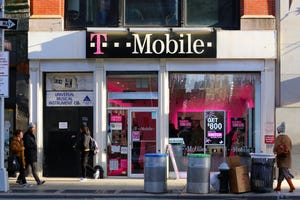AT&T strikes back at lead fears
'Although the Journal seeks to raise the specter of a broad public health issue, lead-clad telecom cables make up a small part of AT&T's network,' AT&T said.

AT&T said that lead-covered cables represent less than 10% of its total copper network footprint, which spans around 2 million miles of cable. And according to one of the financial analyst firms covering the company, AT&T might ultimately spend just $84 million per year cleaning up those potentially hazardous cables.
The figures are noteworthy considering investors panicked this week over the potential costs posed by lead-covered cables. AT&T, Verizon, Lumen Technologies and Frontier Communications collectively lost around $33 billion in market value as a result, according to the financial analysts with KeyBanc Capital Markets, with AT&T (down $15.4 billion) and Verizon (down $15.3 billion) experiencing the majority of that slide.
The situation stems from a series of detailed, lengthy articles by The Wall Street Journal on aging telecommunications cables that may contain hazardous amounts of lead. The publication's exposé acted like a sledgehammer on shares of AT&T, Verizon and other telcos amid reports of cleanup costs totaling up to $60 billion.
AT&T responds
But late Tuesday, AT&T issued its first comprehensive response to the reports. In a court filing, the company said it would halt plans to remove lead-covered cables in Lake Tahoe, California, in order to conduct more testing. The company had agreed to do so as part of a 2021 lawsuit settlement in which the company didn't admit any wrongdoing but did agree to remove the cables at a cost of up to $1.5 million.
In its new filing, AT&T said that "although the Journal seeks to raise the specter of a broad public health issue, lead-clad telecom cables make up a small part of AT&T's network. Based on its records. AT&T estimates that lead-clad cables represent less than 10% of its copper footprint of roughly two million sheath miles of cable, the overwhelming majority of which remains in active service. More than two thirds of its lead-clad cabling is either buried or in conduit, followed by aerial cable, and with a very small portion running underwater. There are varying costs of installation, maintenance, and removal by cable type (aerial, buried, buried in conduit, underwater)."
AT&T also on Tuesday reached out to some investment firms to quell fears over the issue. "AT&T IR [investor relations] hosted an impromptu investor call laying out the framework on the toxic lead-clad cable risk," according to the financial analysts at TD Cowen. "The framework suggests minimal health risk, minimal cable exposure, minimal financial risk (we estimate $246 million/year), and remedied over many years, if any risk at all."
The estimates from the analysts at TD Cowen are slightly higher than those from the financial analysts at Raymond James.
Counting the cost
"AT&T is telling us that the total exposure is 200,000 route miles or less. Additionally, they are advocating that 2/3 of these lines are buried or in conduit," the firm wrote in a lengthy note on the topic Wednesday. "The scientific conclusion for addressing lead cable is to encapsulate any parts that might contact humans, and otherwise leave it in place. This would apply to the 2/3 figure AT&T gave, in our view. We believe the implication for AT&T's data is that the route miles that should be addressed most immediately is about 3.3% (or less)."
The Raymond James analysts estimate it may cost between $34,000 and $68,750 per mile of cabling to clean up lead-covered cables that are underwater. But the average cost for cleanup across all of AT&T's network is more like $4,000 to $6,000 per mile, they argued. Thus, they estimate total removal costs of between $264 million and $1.2 billion.
"The truth is probably somewhere in the middle but if it is determined that it all must be removed, and if the process follows those of the EPAs 2021 Lead Copper Rule (LCR) at 7% removal/year, the risk to AT&T is something in the neighborhood of $84 million/year," they concluded.
Other operators too are working to address the topic. For example, TDS Telecom earlier this week said it conducted an assessment of its communications network across the country and located approximately ten miles of lead-covered cables. And on Tuesday, Shenandoah Telecommunications Company said it conducted an assessment of its communications network "and confirmed that no lead-covered cables are deployed in the network."
In general, financial analysts are now arguing that initial fears over lead-covered cabling were overblown, and that it's unlikely that AT&T and other telecom carriers will face any substantial costs related to the issue. Indeed, shares in AT&T and other telecom providers continued to rise in trading Wednesday.
Related posts:
— Mike Dano, Editorial Director, 5G & Mobile Strategies, Light Reading | @mikeddano
About the Author(s)
You May Also Like












